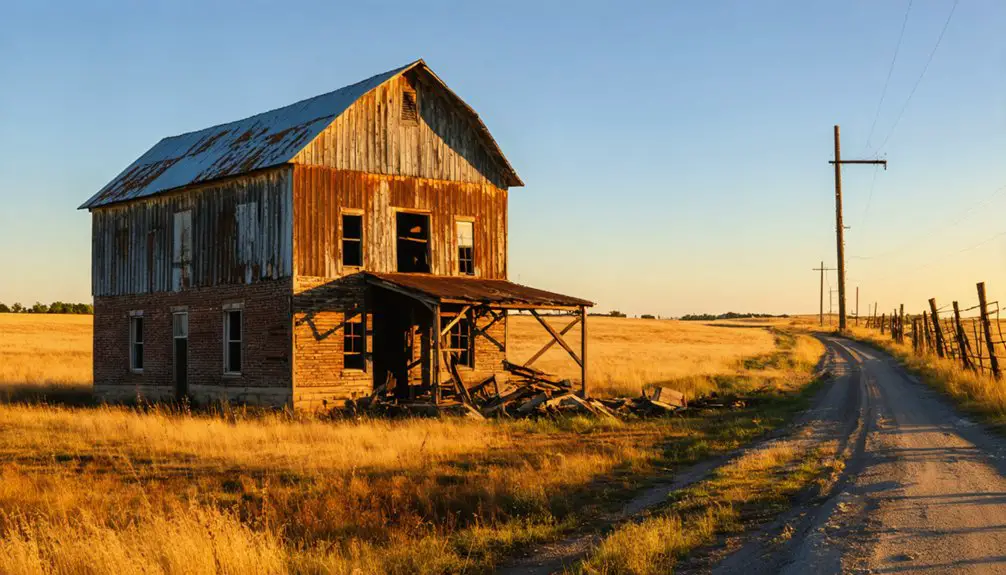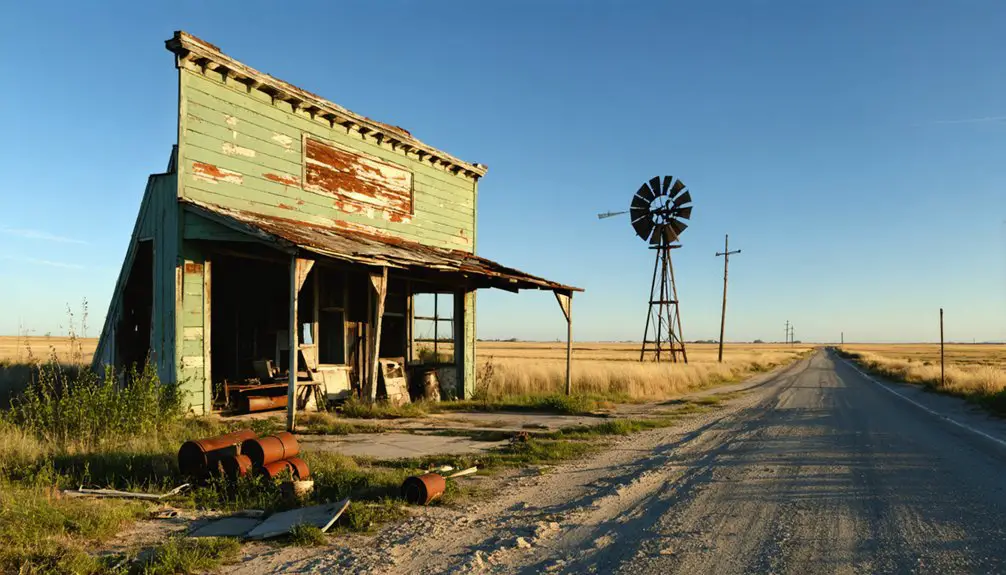You’ll find Fermoy’s abandoned townsite in Saint Louis County’s McDavitt Township, about four miles north of Kelsey near Sax. This former Great Northern Railway junction emerged in the late 19th century, playing an essential role in transporting iron ore and timber throughout northeastern Minnesota. Today, nature has reclaimed the settlement, which now exists within the Fermoy Wildlife Management Area. The site’s transformation from bustling rail hub to ghost town reveals a fascinating chapter of Iron Range history.
Key Takeaways
- Fermoy emerged as a significant rail junction in the late 19th century, serving the Great Northern Railway network in northeastern Minnesota.
- Located in Saint Louis County’s McDavitt Township, Fermoy developed around railway infrastructure near the communities of Sax and Kelsey.
- The town’s economy relied heavily on railway transportation, moving iron ore and timber throughout the region.
- Fermoy declined when changing transportation patterns and economic isolation led to population loss and business closures.
- Today, the ghost town site is part of the Fermoy Wildlife Management Area with few visible remains of its past.
Rail Junction Legacy and Historical Significance
As railroads expanded across Minnesota in the late 19th century, Fermoy emerged as an essential junction point on the Great Northern Railway network, situated four miles north of Kelsey in McDavitt Township.
You’ll find that this strategic location played an important role in connecting local rail lines to mainline service, facilitating the movement of iron ore and timber throughout northeastern Minnesota.
The junction’s significance went beyond mere transportation – it was a critical link in the region’s economic development. Within St. Louis County, Fermoy helped establish vital transportation connections across the state’s largest county.
Through Fermoy’s rail connections, the Great Northern Railway and its subsidiaries established direct routes between the iron ranges and major shipping ports like Duluth.
You can trace how this infrastructure helped integrate remote areas into the broader economic network, supporting both the mining industry and local communities during the Iron Range era.
Just as Fermoy, Ireland saw its development shaped by John Anderson in 1791, Minnesota’s Fermoy junction played a pivotal role in regional growth through transportation infrastructure.
Location and Geographic Features
While many ghost towns fade into obscurity, Fermoy’s precise location in Saint Louis County‘s McDavitt Township remains well-documented at section 28, Township 55 North, Range 18 West.
You’ll find this former railway junction about four miles north of Kelsey, near the community of Sax. The site’s topographical features reflect northern Minnesota’s glacially-formed landscape, with gentle rolling hills and mixed forest cover. Unlike its Irish namesake situated on the River Blackwater, this Fermoy developed around railway infrastructure rather than waterways. Bureau of Land Management records have preserved the legal descriptions and exact coordinates for modern researchers.
The area’s hydrological characteristics include scattered wetlands and small lakes typical of the Mesabi Iron Range region.
- USGS 7.5-minute maps capture detailed elevation data for precise site identification
- Strategic position along the Great Northern Railway enhanced regional connectivity
- Local terrain combines forestry, mining, and transportation corridors
- Natural drainage patterns shape the area’s numerous small water bodies
- County roads 44 and 55 provide modern access to this historic location
Factors Behind Town Abandonment
The documented location of Fermoy tells only part of its story – the reasons behind its abandonment reveal deeper economic and social patterns that shaped Minnesota’s ghost towns.
Like many Minnesota settlements in the late 1800s, Fermoy faced intense competition from railroads as river-based trade declined. Early settlers endured harsh winters that made sustaining a livelihood particularly challenging. Fermoy’s economic vulnerability stemmed from its dependence on the Great Northern Railway, which couldn’t sustain the town once transportation needs evolved. You’ll find that demographic decline accelerated as younger residents sought opportunities in larger urban centers.
Like many small Minnesota settlements, Fermoy suffered from the ripple effects of regional consolidation. When neighboring towns offered better services and employment prospects, residents gradually relocated.
The town’s inability to diversify beyond its railway-dependent economy, combined with the broader shifts in agricultural mechanization and changing transportation patterns, ultimately sealed its fate as another lost settlement on Minnesota’s landscape.
Transportation Network Impact
Due to its geographic isolation from major railway routes, Fermoy’s transportation network suffered a critical blow when the Southern Minnesota Railroad bypassed the settlement in favor of Wykoff and Spring Valley during the late 1860s expansion.
The transportation evolution led to profound economic isolation as the town’s once-vital stagecoach connections became obsolete. Similar to the decline of Forestville in 1868, the shifting transportation landscape devastated local commerce. The rise of steam locomotives transformed Minnesota’s transportation system, making unconnected towns increasingly irrelevant. You’ll find that Fermoy’s inability to adapt to changing transport modes sealed its fate.
- Loss of direct rail access shifted local markets away, devastating trade opportunities
- Decline in stagecoach traffic eliminated traditional transport-based commerce
- Absence of river or ferry advantages limited alternative transportation options
- Rural free postal delivery reduced the need to visit town for essential services
- Lack of integration into modern road networks prevented economic recovery
Present-Day Status and Preservation

Located near Sax and Kelsey in Saint Louis County, Minnesota, Fermoy exists today as little more than an abandoned townsite reclaimed by nature.
You’ll find few visible remnants of its past, as decades of weathering and ecological restoration have obscured most traces of human settlement. Like many ghost towns across the state, the land has returned to fields with no structures remaining. The surrounding Fermoy Wildlife Management Area now dominates the landscape, prioritizing natural conservation over historical preservation. Like many communities in Minnesota that faced economic decline post-Cold War, Fermoy gradually lost its population and vitality.
Unlike other Minnesota ghost towns that have become tourist destinations, Fermoy faces unique preservation challenges.
While some abandoned Minnesota towns draw visitors and preserve their past, Fermoy’s heritage slowly fades into wilderness.
You won’t find any maintained structures, historic markers, or visitor facilities. The site lacks formal recognition from state heritage authorities, and no active conservation projects protect its cultural significance.
The area’s current land use policies focus primarily on wildlife management, leaving Fermoy’s history largely unmarked and untold.
Frequently Asked Questions
What Was the Peak Population of Fermoy During Its Most Active Period?
While Fermoy’s exact demographics aren’t documented, you’ll find its peak population likely reached between 100-200 residents, following patterns of similar Minnesota ghost towns before population decline emptied the settlement.
Were There Any Notable Businesses or Industries Besides the Railway Station?
You won’t find detailed records of significant businesses in Fermoy beyond the railway station, though like other Minnesota ghost towns, it likely had basic services supporting railroad operations.
What Original Buildings or Structures Still Remain at the Fermoy Site?
You won’t find any original buildings standing at this site today. Despite its railway heritage and potential architectural significance, no historic preservation efforts have documented surviving structures in this remote location.
When Was the Last Resident Known to Have Lived in Fermoy?
You won’t find exact records of Fermoy’s last resident, though regional patterns suggest they’d departed by the mid-20th century. Unlike other ghost towns nearby, there aren’t documented ghost stories or final inhabitant accounts.
Did Any Significant Historical Events or Notable People Originate From Fermoy?
Like a quiet whisper in Minnesota’s past, you won’t find any notable residents or significant historical events originating from Fermoy’s history – it served simply as a modest railway junction.
References
- https://www.youtube.com/watch?v=5bCG6B2rzZY
- https://www.mprnews.org/episode/2023/01/23/a-minnesota-ghost-town-or-a-town-that-never-was
- https://en.wikipedia.org/wiki/Fermoy
- https://en.wikipedia.org/wiki/List_of_ghost_towns_in_Minnesota
- https://wikipedia.nucleos.com/viewer/wikipedia_en_all/A/List_of_ghost_towns_in_Minnesota
- http://genealogytrails.com/minn/stlouis/historyname.html
- https://www.dot.state.mn.us/culturalresources/docs/rail/sectione.pdf
- https://www.dot.state.mn.us/culturalresources/docs/rail/rrfpr.pdf
- https://www.stpaul.gov/sites/default/files/2022-08/2013 Railroads in Minnesota 1862-1956.pdf
- https://www.wikiwand.com/en/map/Fermoy



